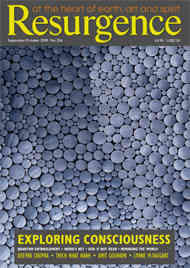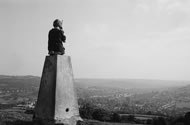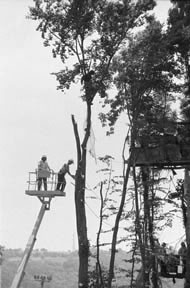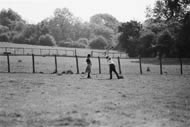On a fine day in May 1994 two overdressed policemen struggled up to the camp on Solsbury Hill. Averting their eyes from a naked woman stretched out in the sun, they asked to be taken to the leaders. “You want to talk to Aqua and Sulis,” someone told them. “They’re up the top. You’ll recognise them ’cos they’re both black.”
The officers sweated up to the top of the hill. They told the people there who they wanted to talk to. Everyone stared at them. “Aqua and Sulis? You sure about that?”
“Definitely.”
“Right.”
They were taken to meet the two black piglets.
No-one returned from Solsbury Hill unchanged. The battle against the Batheaston bypass was a turning point both in the fight against the government’s road- building programme and in the lives of many of the people who became involved. The protest began at a critical moment, when a raw, uncertain movement had begun to coalesce and find its voice. People emerged at the other end with a sense that life was richer – richer with experience and possibility – than they had imagined.
By the time the fight over Solsbury Hill started, in the spring of 1994, the road protest movement had already experienced some defeats. Campaigners had lost against the motorway being built through Twyford Down in Hampshire and had been evicted from most of the route of the M11 through East London, but in losing they had begun to turn public opinion against the government’s programme.
During one of the greyest periods in modern British politics, the road protest movement provided both colour and hope. While most people expressed their disagreements with the fading Conservative government politely, the roads protesters put their bodies in the way. In doing so they focused public anger towards a government that wouldn’t listen, a politics that put money ahead of human beings, a philosophy that placed no value on anything that couldn’t be quantified.
The Tory road-building programme epitomised that worldview. Under Margaret Thatcher, the government had decided to build a network of new motorways and trunk roads in order to realise her dream of universal driving. Hers was a programme not just to facilitate car ownership but also to close down the alternatives. It was Thatcher who told us that “a man who, beyond the age of twenty-six, finds himself on a bus can count himself as a failure”. “Nothing”, she insisted, “should be allowed to stand in the way of the great car economy.”
“Nothing” included public opinion and local democracy. The consultation process for constructing a new motorway consisted of announcing that the road was to be built then asking people to comment on which route it should take. The Department of Transport would identify four or five potential routes, all but one of which were implausible. The one it favoured would join up the dots between sites of special scientific interest, scheduled ancient monuments, commons and ancient woodlands. Objectors were not even able to discuss the route as a whole. Projects like the road through the side of Solsbury Hill were presented as bypass schemes to relieve local traffic congestion. In reality, as leaked documents showed, the government’s plan was to join them together to create new routes. The ‘Batheaston bypass’ was originally intended as one small section of a dual carriageway which would run from the M4 to Southampton. But any discussion of the new road as something other than just a local bypass was “outside the scope of the inquiry”. The government was seeking to build new motorways by stealth.
We fought for Solsbury Hill for all of these reasons; because of what it was and what it represented. It was one of the few quiet places in a corner of England that was becoming ever noisier; a scene of slow beauty, of rough pasture, elder coverts and dense hedges, capped with an ancient hill fort. It epitomised the places we were losing to development in every county. Some of the protesters were local people, others had come from all over the country. Opponents characterised all of them as ‘outsiders’ who had no right to interfere in a local scheme. But we were fighting a national road-building programme, run by central government, funded by taxpayers, damaging places of national significance. We could make an impact only if we came together in one place.
When the first bedraggled refugees from Tory Britain arrived at Solsbury Hill in incessant rain and a sea of mud, they were still ahead of the police, bailiffs and private security guards who had not yet learnt how to extract people easily from the trees. Nor had the draconian laws – such as the Criminal Justice Act passed at the end of 1994, the 1997 Protection from Harassment Act or the 2005 Serious Organised Crime and Police Act – yet been passed which would have made the whole protest illegal. Britain, to an extent perhaps forgotten today, was still free.
The first permanent arrivals at the camp built simple shelters on the ground of hazel sticks and canvas, and rudimentary tree-houses as high as they dared to live. But as more people came and the campaigners learnt new techniques, the structures in the trees became more elaborate and moved further from the ground. Some people learnt to swing from arm to arm like gibbons or to scuttle up the trunks like squirrels. They seemed after a while to lose all fear of heights. At times the place looked more like a circus than a protest camp.
Solsbury Hill and the other road protests of the 1990s helped make us the country we are today. Solsbury leaves us with lessons: some of today’s office-bound environmentalists, talking of parts per million of carbon and the importance of ‘sustainable development’, would do well to remember that green politics, if it means anything, is born from a love of the natural world, and that a love of the natural world is fostered by being part of it. A sense of place, the smell of a night fire and the sensation of rain leaking through a bender roof are better guides to what is right and wrong than any number of policy papers.
As a nation, meanwhile, we might consider that what seems a minor development at the time can very quickly reveal itself to be part of something much bigger. Just as the Solsbury ‘bypass’ was not a bypass at all but a small piece in a giant motorway jigsaw, so the mindset that built it was part of a vast and dominant global ideology which today has gifted us a nation littered with ring roads, chain malls, faceless box warehouses, airport runways, boarded-up high streets and dying local communities; all the detritus of the twenty-four-hour global economy in which growth is god and everything else is a side-effect.
We lost the fight over Solsbury Hill, and Bath has been left with a high-spec dual carriageway to nowhere. We lost Newbury, Pollok Park, Fairmile and half a dozen others. But in doing so, we won the rest. By 1996, before the Conservatives had left office, the road protests helped to cut Britain’s road-building budget from £23 billion to £4.5 billion. By fighting a few schemes and bringing the absurdities of the roads programme to public notice, we helped destroy the philosophical basis of the roads programme. It is probably true to say that a new motorway-building plan of the kind the Conservatives envisaged can never be relaunched. Building our way out of congestion and pollution is a discredited idea, and for this the campaigners of Solsbury Hill can claim some responsibility. In that respect, at least, victory was ours.
Extract from the Foreword of Solsbury Hill: Chronicle of a Road Protest by Adrian Arbib, published by Bardwell Press, 2009, ISBN 9781905622207.









